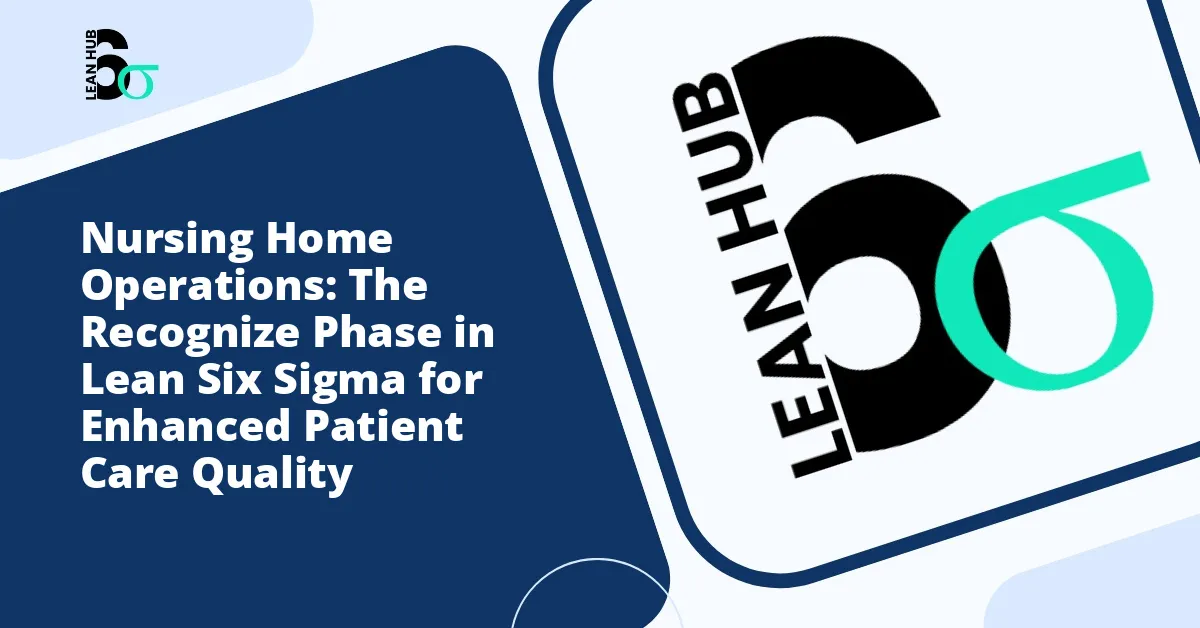The healthcare industry faces mounting pressure to deliver exceptional patient care while managing costs and optimizing operational efficiency. Nursing homes, in particular, must balance compassionate care with streamlined processes to serve an aging population effectively. One proven methodology that has transformed manufacturing and business operations is now revolutionizing healthcare facilities: Lean Six Sigma. At the heart of this transformative approach lies a critical first step often referred to as the recognize phase, where facilities identify opportunities for improvement and lay the foundation for meaningful change.
Understanding Lean Six Sigma in Nursing Home Settings
Lean Six Sigma combines two powerful methodologies that complement each other remarkably well. Lean focuses on eliminating waste and improving flow, while Six Sigma emphasizes reducing variation and defects through data-driven decision making. When applied to nursing home operations, this hybrid approach creates a systematic framework for enhancing patient care quality, improving staff satisfaction, and optimizing resource utilization. You might also enjoy reading about Hospital Supply Chain: How to Recognize Inventory and Procurement Problems Using Lean Six Sigma.
The methodology typically follows a structured approach known as DMAIC: Define, Measure, Analyze, Improve, and Control. However, before formally entering the Define phase, successful organizations engage in what practitioners call the recognize phase, an essential preparatory step that sets the stage for sustainable improvements. You might also enjoy reading about How to Execute the Recognize Phase in Hospitals: A Comprehensive Guide to Reducing Patient Wait Times.
The Critical Importance of the Recognize Phase
The recognize phase serves as the foundation upon which all subsequent improvement efforts are built. During this preliminary stage, nursing home administrators, care staff, and stakeholders identify potential areas where quality gaps exist, operations falter, or patient satisfaction suffers. This phase requires honest assessment, open communication, and a willingness to acknowledge imperfections in current systems. You might also enjoy reading about Big Data and AI: Modern Approaches to the Recognize Phase in Lean Six Sigma.
Unlike formal problem definition, the recognize phase is more exploratory and observational. It involves gathering initial impressions, listening to staff concerns, reviewing patient feedback, and observing daily operations without immediately jumping to solutions. This patient, thoughtful approach prevents organizations from rushing into improvements that address symptoms rather than root causes.
Key Activities During the Recognize Phase
Stakeholder Engagement and Communication
Successful recognition begins with engaging all stakeholders in the nursing home ecosystem. This includes direct care staff such as nurses and certified nursing assistants, administrative personnel, family members of residents, and the residents themselves when appropriate. Each group possesses unique insights into operational challenges and quality concerns that might otherwise remain hidden from leadership.
Creating forums for open dialogue, such as town hall meetings, suggestion boxes, or structured interviews, helps capture diverse perspectives. Frontline staff often notice inefficiencies or safety concerns that don’t appear in formal reports, while family members can provide valuable feedback about communication gaps or care inconsistencies.
Preliminary Data Collection and Observation
During the recognize phase, nursing homes should begin collecting baseline data without the rigor required in later Lean Six Sigma stages. This preliminary information gathering might include reviewing incident reports, examining medication error rates, analyzing staff turnover statistics, or tracking patient fall frequencies. The goal is not statistical perfection but rather identifying patterns that suggest underlying problems.
Direct observation proves equally valuable. Leaders should spend time on the floor, watching care delivery processes, noting bottlenecks, and understanding the actual work environment. This practice, sometimes called “going to the gemba” in Lean terminology, reveals disconnects between how processes are supposed to work and how they actually function in daily practice.
Identifying Pain Points and Opportunities
The recognize phase emphasizes identifying both problems and opportunities. Pain points might include long wait times for call button responses, confusion during shift changes, medication administration delays, or inadequate documentation practices. Opportunities could involve underutilized technology, staff skills that aren’t being leveraged, or best practices from one unit that haven’t spread to others.
Creating a comprehensive list of potential improvement areas allows leadership to prioritize initiatives based on impact, feasibility, and alignment with organizational goals. Not every identified issue will become a formal Lean Six Sigma project, but recognizing the full landscape of challenges ensures that selected projects address the most pressing needs.
Common Quality Concerns in Nursing Home Operations
The recognize phase often uncovers similar categories of concerns across nursing home facilities. Understanding these common patterns helps organizations know where to look:
- Medication Management: Errors in medication administration, storage issues, or delays in obtaining medications from pharmacies
- Fall Prevention: Inadequate monitoring systems, environmental hazards, or insufficient staffing during high-risk periods
- Communication Breakdowns: Information gaps during shift handoffs, unclear documentation, or ineffective family communication channels
- Admission and Discharge Processes: Lengthy paperwork procedures, missing information, or poor care transitions
- Staff Scheduling and Workload: Uneven distribution of responsibilities, inadequate coverage during peak times, or excessive overtime requirements
- Infection Control: Inconsistent protocol adherence, supply shortages, or inadequate training
- Resident Satisfaction: Delays in responding to requests, limited activity options, or food service complaints
Building a Culture Receptive to Change
The recognize phase is not merely about identifying problems but also about cultivating an organizational culture that embraces continuous improvement. Nursing homes with deeply entrenched routines may face resistance when introducing Lean Six Sigma methodologies. Leaders must emphasize that recognition of problems is not about assigning blame but about creating better systems that support staff and residents alike.
Transparent communication about the purpose and benefits of the recognize phase helps reduce anxiety. Staff members need assurance that their jobs are not at risk and that their input is genuinely valued. When employees understand that improvements aim to make their work easier and more meaningful, they become willing partners in the transformation process.
Transitioning from Recognize to Define Phase
Once the recognize phase yields a robust list of potential improvement opportunities, leadership must make strategic decisions about which issues to address first. Prioritization criteria typically include the severity of impact on patient safety and quality, the frequency of the problem’s occurrence, alignment with regulatory requirements, and the availability of resources to support the project.
Selected issues then move into the formal Define phase of Lean Six Sigma, where teams create detailed problem statements, establish project charters, define scope boundaries, and set measurable goals. The insights gathered during the recognize phase provide essential context that shapes how these formal projects are structured and executed.
Real World Impact on Patient Care Quality
Nursing homes that dedicate adequate attention to the recognize phase position themselves for meaningful, sustainable improvements. By taking time to truly understand operational challenges before implementing solutions, these facilities avoid common pitfalls such as addressing the wrong problems, implementing solutions that create new problems, or pursuing improvements that staff won’t actually use.
The benefits extend beyond operational metrics. Residents experience more consistent, attentive care. Staff members feel heard and empowered. Family members gain confidence in the facility’s commitment to excellence. Regulatory compliance improves as systematic approaches replace reactive problem-solving. These outcomes collectively elevate the nursing home’s reputation and competitive position in the marketplace.
Conclusion
The journey toward operational excellence in nursing home care begins not with solutions but with recognition. The recognize phase of Lean Six Sigma provides a structured yet flexible framework for identifying opportunities to enhance patient care quality. By engaging stakeholders, collecting preliminary data, observing actual practices, and cultivating a culture of continuous improvement, nursing homes lay the essential groundwork for transformative change.
Healthcare leaders who resist the temptation to rush past recognition and move directly to solutions often discover that patient attention to this preliminary phase pays substantial dividends. The insights gained, relationships built, and awareness created during recognition become invaluable assets throughout the entire improvement journey. For nursing homes committed to delivering the highest quality care, embracing the recognize phase represents not an optional preliminary step but an essential investment in sustainable excellence.








